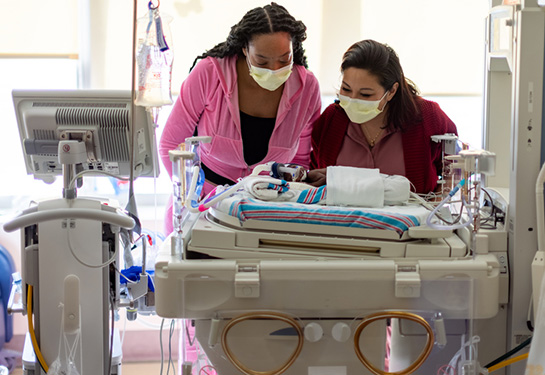Treating nephrocalcinosis in newborns: A primer for clinicians
As many as 40% of preterm infants in the U.S. suffer from nephrocalcinosis, a condition that deposits excess calcium in kidneys. Unfortunately, it’s often underdiagnosed. Neonatologists don’t always check for nephrocalcinosis, even though it can be serious. Sometimes nephrocalcinosis is found incidentally while investigating other concerns.
Two UC Davis pediatric nephrologists concerned about nephrocalcinosis in newborns are raising awareness about it through a recently published journal review. Lavjay Butani and Gia Oh wrote in the journal NeoReviews about the disease’s natural history and offered tips to help clinicians identify nephrocalcinosis and treat it successfully.
“Nephrocalcinosis is often under-recognized because it can be asymptomatic,” Butani said. “Nephrologists are familiar with it, but neonatologists in the neonatal intensive care unit may not be as aware. We wanted to demystify the condition and make people aware that it is fairly common. Clinicians should know when to look for it, how to look for it and, if they find it, how to begin treatment.”
Preterm infants can experience nephrocalcinosis because their blood-filtering renal tubes are immature and cannot adequately manage calcium. Also, because these babies can have multiple health issues that must be addressed simultaneously, interventions can sometimes exacerbate nephrocalcinosis. The wrong diuretic, for example, can lead to greater calcium deposition.
The article describes different types of nephrocalcinosis and how to approach these variations. In premature babies, the disease is caused by immature kidneys; however, it generally resolves in about six years. Still, the condition must be actively managed during that period, and long-term follow up is essential. The article recommends:
- choosing the right diuretic
- controlling dietary calcium and vitamin D
- delivering extra fluids
“If the nephrocalcinosis is indeed assessed to be due to prematurity rather than a tubulopathy, this can be quite reassuring for families as prematurity-related nephrocalcinosis will resolve over time, while a hereditary tubulopathy is a life-long disease,” Oh said.
Other signs to notice
Neonatologists should be more concerned if the baby has a family history of kidney stones or kidney failure. Other markers include:
- diffuse calcium deposition in the kidneys
- high serum calcium levels and/or concurrent electrolyte abnormalities, which might indicate the presence of a group of genetic conditions called tubulopathies.
- low potassium and high bicarbonate might point towards Bartter syndrome, which makes it difficult for kidneys to reabsorb salt.
“There are newer therapies available for some of these genetic conditions, which is encouraging,” Butani said. “But it’s so important to diagnose babies early. The sooner we diagnose, the faster we can start treatment and improve long-term outcomes.”
Nephrocalcinosis is often under-recognized because it can be asymptomatic. Clinicians should know when to look for it, how to look for it and, if they find it, how to begin treatment.”—Lavjay Butani
The authors hope their article will give neonatologists better tools to quickly identify and manage nephrocalcinosis and prevent the most serious symptoms, such as high blood pressure and kidney failure. They also recommend clinicians consult with a nephrologist as soon as they suspect nephrocalcinosis.
“Even if the baby does not have nephrocalcinosis, being preterm often means they will have long-term kidney issues,” said Oh. “They will definitely need consistent follow up, and the family should be working closely with a nephrologist.”
Learn more about pediatric nephrology at UC Davis Children’s Hospital.







